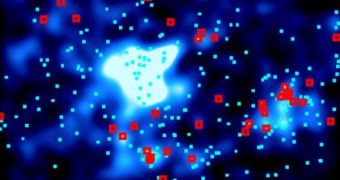Astronomers say that a recent study of a distant galaxy cluster has finally revealed the locations of red star-forming galaxies they've been searching for many years. The cluster is located around 4 billion light-years away from Earth.
In order to conduct this investigation, the team used the 8.2-meter flagship telescope of the National Astronomical Observatory of Japan (NAOJ). The Subaru Telescope is located at the Mauna Kea Observatory, in Hawaii.
Investigators from NAOJ and the University of Tokyo say that these red-burning galaxies go a long way towards demonstrating the evolution of galaxies in the environment surrounding the cluster.
At the same time, studying such large-scale structures could reveal additional details of transitional phases in the galaxy development process. Experts believe that red-burning galaxies represent a little-studied step in the evolution of young-generation galaxies to older ones.
Following this line of thought, researchers decided to focus their attention on cosmic regions where they were most likely to find such objects in bulk. They say that the probability of finding red star-forming galaxies on the outskirts of galactic cluster is very high.
“The birth of galaxies occurred more than ten billion years ago in the ancient Universe. Assembled under their own gravity, early galaxies formed into big clusters or small groups,” a NAOJ press release accompanying the study notes.
“During the process of assemblage, their properties changed in relation to their surrounding environments, just as human traits change in the contexts of their lives,” the document goes on to say.
“For example, galaxies grouped in high-density environments such as clusters tend to be elliptical or lenticular while solitary ones tend to be spiral galaxies. How galaxies form and evolve is one of the biggest mysteries in recent extragalactic astronomy,” NAOJ experts add.
The research team that carried out the new investigation was led by Dr. Yusei Koyama. He and his group used the Subaru Prime Focus Camera (Suprime-Cam), an instrument that is capable of conducting panoramic observations of the night sky.
After some thinking, the group decided to focus its investigation on CL0939+4713, a very rich galactic cluster that had been previously observed in ultraviolet wavelengths by the NASA Hubble Space Telescope.
Japanese experts now plan to conduct follow-up studies, in order to determine the physical origin of these red-burning galaxies, as well as the reason for why they are concentrated in groups and not in clusters.

 14 DAY TRIAL //
14 DAY TRIAL //